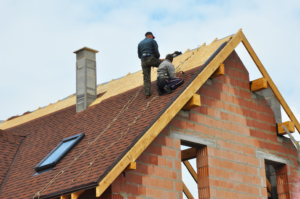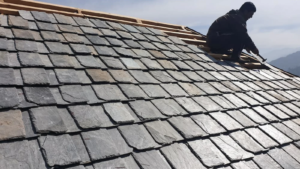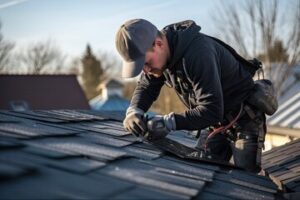Your roof is your home’s shield, protecting it from extreme weather. It’s a complex structure that requires skill to build, maintain, and repair.
Roofing encompasses a wide range of tasks, from inspecting leaky spots to replacing worn shingles. It also includes assessing roof penetrations and performing annual inspections. A roof’s shape and material reflect the needs, climate, and architectural style of a building. Contact Erie Roofing now!

The roofing materials used in a home impact its longevity, durability, and aesthetics. Educating your customers about the different types of roofs available can help them choose the right one for their home. A variety of factors must be considered, including cost, climate, and maintenance needs.
Asphalt shingles are a classic choice that is widely available and affordable. They are durable and if properly maintained, last 20 years or more. They are also easy to repair and replace as needed. Other options include 3-tab and architectural shingles, which are a bit more expensive but offer better resistance to wind and hail damage.
Those who prefer flat roofing can opt for EPDM membrane, a rubber-based option that is long-lasting and easy to install. It is made from large sheets that minimize seams, which are then glued together. It also resists punctures, bacterial growth, and standing water. Another flat-roof option is TPO, which combines the benefits of EPDM with thermal protection. It can withstand extreme heat and UV rays, which helps keep energy costs lower.
Other roofing material options include concrete tile, which is durable and can mimic the appearance of other types of roofs. However, it is heavy and can put a lot of stress on the structure of the house. It is also less resistant to cold weather than clay tile and is vulnerable to water absorption.
Wood shingle or shake roofs are more traditional and add a rustic look to the home. They are durable and, if properly maintained, can last for 50 years or more. They are not ideal for areas that experience seasonal wildfire danger, though, and require a fire-resistant coating that can add to the price.
Slate is a beautiful, natural roof material that is incredibly durable and will last 100 or more years. It is very heavy, though, and requires a specialist to install it. It is also expensive, and shipping costs can be prohibitive. Other natural roof materials to consider include cedar, cypress, and redwood.
Installation
The roof shields a home from the elements. While the roof itself may seem to be a solid, invulnerable structure, it actually has a lot more going on beneath the surface. Roofing is the process of installing, maintaining and repairing this critical outer layer.
The Roofing Process
Before work begins, the crew will set up to protect your property. They might cover your landscaping and shrubs with tarps so that any falling debris doesn’t damage them, and they might put down wooden boards to keep vehicles off of the area. They’ll also cover any outdoor drains to prevent small pieces of debris from clogging them up.
Once they’ve got everything in place, the crew will remove the existing shingles and underlayment. They’ll also check the decking to see if it needs replacing. The decking is the surface that supports the shingles and other materials, so it’s important to ensure that it’s in good condition.
As they work, the crew will install a waterproof membrane underneath the shingle layers. This underlayment serves as a second line of defense against leaks, and it can protect the interior from water infiltration even if the shingles themselves are damaged.
Throughout the installation process, the crew will use standard roofing tools like hammers and nail guns, shingle cutters, hard hats and harnesses, and ladders. Larger jobs might require additional construction equipment like forklifts. Workers are also exposed to fall hazards, so it’s important that they follow safety procedures to protect themselves. Resources to help include safety plans, a ladder safety mobile application, infographics and tipsheets, toolbox talks, and training programs.
Maintenance
The roof is a vital component of any structure and should be maintained regularly to ensure its integrity. This is particularly important in harsh climates or buildings with significant exposure to the elements. Performing surface maintenance is relatively inexpensive and can reduce the need for major repairs down the road.
Regular inspections can help homeowners or building owners spot potential problems before they become worse. Many small issues have the potential to cause water leaks or damage the interior of the structure. Identifying and addressing these problems as soon as they are detected is the best way to protect the investment in a roof.
Routine maintenance procedures should be tailored to the specific requirements of each roofing system. For example, a metal roof may require a different maintenance procedure than a tile roof. In addition, a maintenance plan should include a schedule of inspections and repairs that is appropriate for the climate where the roof is located.
Performing regular maintenance is not only important for protecting the integrity of a roof, but it also helps prevent costly repairs and energy losses. It is recommended that homeowners perform routine surface maintenance and contact a professional roofer for more involved or complex repairs.
A typical roofing inspection should check the following:
Surface Damage – Holes, dents, and rips should be patched or repaired promptly to prevent water infiltration.
Leaks – Detection of leaks in the attic, ceiling, or walls is an indicator that the roof requires repair.
Shingle Damage – Loose or missing shingles expose the asphalt layer to the elements and lead to deterioration.
Clogged Gutters – Overflowing gutters can damage fascia boards and block rainwater drainage, leading to water infiltration.
Moss or Algae – These can trap moisture, speeding shingle deterioration.
Debris – Clearing the roof of leaves, twigs, and other debris is important to prevent moisture build-up.
Other maintenance items to consider are:
Repairs
Whether you are repairing leaks or addressing sagging areas, it’s important to address these issues promptly to ensure that your roof remains strong and stable. If you let these problems linger, they can lead to significant structural damage over time.
In addition, a well-maintained roof offers a number of other benefits. It can improve the energy efficiency of your home, reducing heating and cooling costs. It also helps keep moisture out, which can encourage the growth of mold and other hazardous substances.
Finally, a sturdy roof is vital to the overall safety of your family and loved ones. Leaking, worn shingles or flashing can compromise the integrity of your home’s structure, and even cause water or structural damage to other parts of your property.
As mentioned above, roofing is a physically demanding job. It requires significant strength and stamina, as well as the ability to work at heights in all kinds of weather conditions. Even with the right gear and knowledge, this can be a dangerous job. That’s why it’s so important to always use the appropriate safety protocols and work with a licensed contractor whenever possible.

